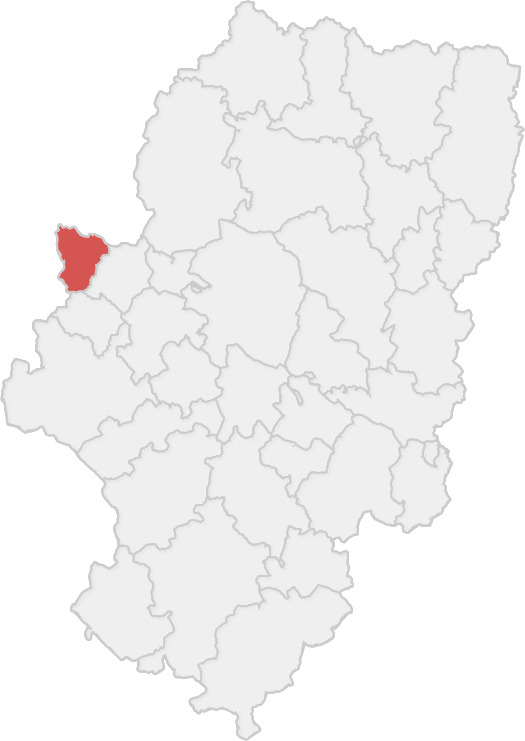Go walking through the somontano de moncayo
The Moncayo and its Somontano, the area nestled at the foothills, includes a range of tiny and peaceful locations full of history, culture and, of course, gastronomy.
The multicolored silhouette of Moncayo
The multicolored silhouette of Moncayo, the highest point of the province of Zaragoza, catches traveler´s eyes arriving the dramatic Natural Park. Discovering the sixteen villages that make up the so-called Somontano del Moncayo Area, getting to know Tarazona Historical heritage, or tasting a rich gastronomy cooked in accordance with local culinary traditions, typically using high-quality locally sourced ingredients, are only some of the options you have.
Here you could get to know to poet Bécquer or settle into discovering the funniest actor Paco Martinez Soria. There is no doubt that this mythical mountain of the Iberial System is the birthplace and spot of inspirations of many artists.
Castles and walls, monasteries and palaces, witches and spells recall the alchemy that surrounds the Natural Park, while Tarazona, as the visible head of the region, centralizes a good number of multicultural attractions that enclose its streets.
Besides, to say that this area is famous by its wine Borja Designation of Origin, the cereals, vegetable garden products grown next to the rivers Queiles, Huecha and Isuela, and others tasty products is an understatement.
Step by step, town by town
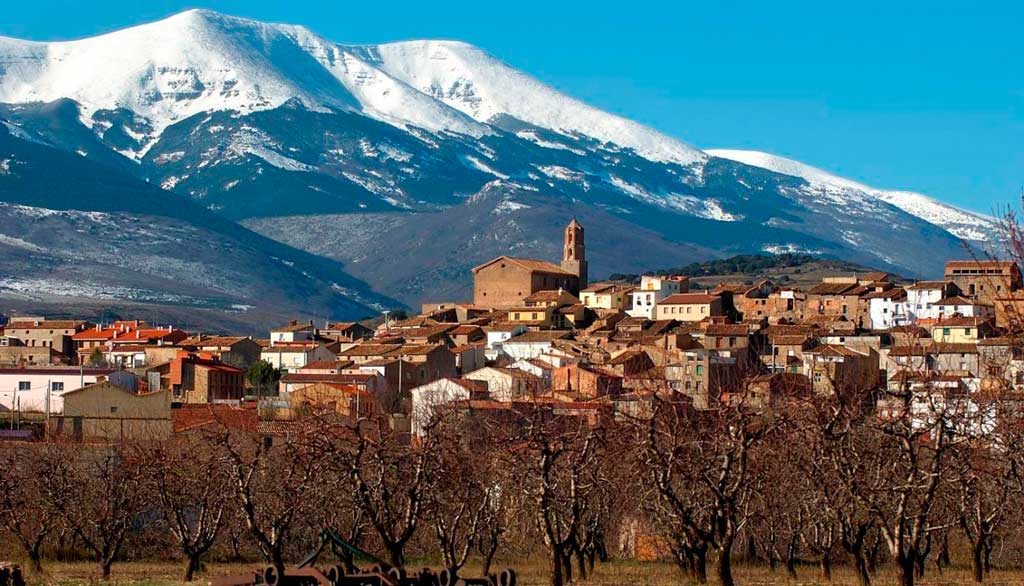
Visitors to Moncayo´s area are served by two major local roads, making access to the region easy by car along the N-122 which flows into Soria lands, and the N-II that runs through the valleys connecting the villages of this area with the old Turiaso. All these communications, which most resemble Little streams flowing down the Moncayo, are suddenly offer colorful pictures out in nature. It is a perfect ode to the beauty of the natural world, yielding spectacular scenes of this mythical hill. Undoubtedly, the most remarkable view of the Somontano is from the summit (2,315 meters). Small towns, spread out over 468 square kilometers, can be seen from there.
The border situation that this region has played, between Castilla-León, La Rioja and Navarra, has left an innumerable textbook of exceptionally rich in cultural heritage: stories, legends, culture and art. The borders feel timeless.
In this abstract path of the Triangle formed by imaginary lines joining Vera de Moncayo, the mountain range and Tarazona, are collected each and every one of the towns that make up one of the regions with the greatest tourist resources of Aragon.
Its beautifully preserved architectural heritage is focused almost exclusively in the architecture and several artistic manifestations of the area. The Monastery of Veruela, is worth a visit. Placed in Vera de Moncayo, it stands proudly and majestically next to the road that goes up the slope of the mountain. The wall, built around monastery, encloses a tranquil cloister, the chapter house, the refectory and other rooms.
From Vera, going on the left side, you can find villages like Alcalá de Moncayo, with its Church of the Assumption of the 16th century, or Añón, another village where the Gothic church of Santa María stands out. If we go ahead the N-122, the singpost will indicate the way to Trasmoz, Litago, Lituénigo and San Martín del Moncayo, one after another. In addition to castles, hermitages and churches, these four small towns, welcome travelers with a wide range of rural accommodation to suit you and keep some amazing deep- rooted traditions as “El pesaje de los niños” (literally “The weighing of children”) of Lituénigo. In this custom, that takes place 4th Sunday in September and is rated as Festivity of Regional Tourist Interest, all the children less than a year old, are weighed in a procedure for Weighing Infants/Children using the “Romana”, an ancient balance of trade. The family of one of the children must pay their weight in wheat as a contribution to the church. This is one of the most popular events of the whole region.
Traditional craftsmanship and ancient crafts skills also fit in a trip through the Somontano del Moncayo. Tarazona, Vera de Moncayo and Torrellas offer visitors shops and workshops where homemade food products, ceramics, wooden works and some other souvenirs can be found.
On the left bank of Queiles´River, on the road that leads to Soria (N-122) the town of Torrellas welcomes travelers by showing them the Church of San Martín de Tours. It´s an old mosque that was rebuilt in the 17th century. Other sightseeing attractions are the hospital (S. XVIII) and the main square, full of charming corners and stone houses.
The castles of Moncayo
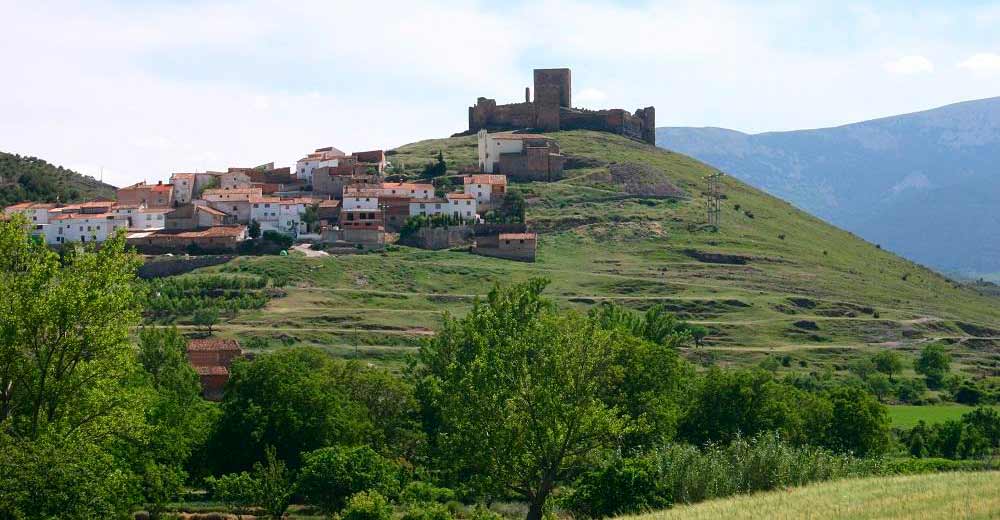
The landscape of the natural park, with bright and captivating colours, is dotted with the remains of numerous castles and fortifications that are extended throughout the entire region.
One of the most breathtaking castles is in Trasmoz and was a setting of several Gustavo Adolfo Bécquer´s tales. On this castle documents dated 1185 are found, under the rule of the king of Navarre. However, The Legends, Tales and Poems by Bécquer are those that have forged the best mystery and suspense stories.
Gustavo Adolfo Bécquer wrote about the castle fortress of Trasmoz: “In that castle, which was built on black slate stone, of which the mountain is formed, and whose ancient walls, made of huge boulders, looks like a work by titans, it is fairly famous for secrets meeting of the surrounding witches.
Following the road that leads to Litago, it is possible to find the last remnants, that are the two watchtowers of the old castle.
Arriving to the village of Añón, the castle that belonged to the Order of San Juan during the Middle Ages, shows a building with towers that was built in the thirteenth century. Going down the curvy roads that lead to Alcalá de Moncayo, the old castle, converted into a parish house and built in the uptown, preserves a semicircular tower that dominates the best views of the town. Before reaching the N-122, Vera de Moncayo contains remains of the 14th century castle with a crenelated tower and fragments of tapestories.
Grisel and Lituénigo, have in common two buildings built in the thirteenth century. Lituénigo´s castle is one of the best preserved with a good part of the exterior.
What was once the castle of Torrellas, was in the uptown, as Malón is, nowadays it serves as a magnificient venue with views of the river Queiles; highly recommended scenic view
Also, the Novallas castle offers birds-eye view over the riverbed, and the Moncayo massif. The current town hall and the museum of this town are found in the old castle.
Some castles just conserve the plot of land such as that in Fayos, dated of century XII, and that in Santa Cruz de Moncayo.
Tarazona: Tour of City´s Cultures and Delights of the fine Old- Town Turiaso
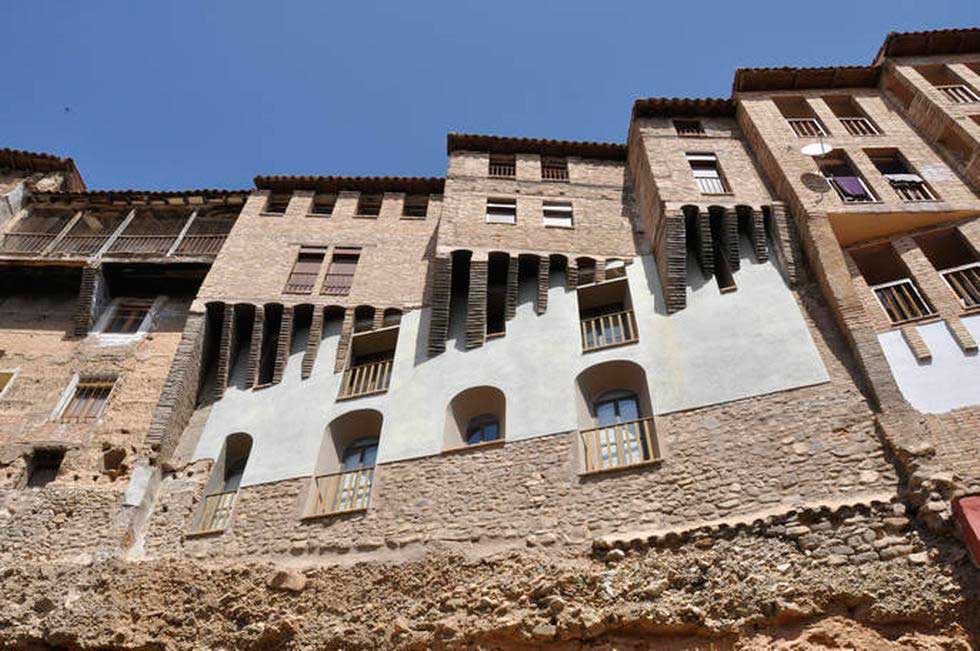
The capital of the Moncayo was established at a crossroads of paths, that has made it an astounding melting pot, with a rich legacy thanks to the multicultural peoples settled there. Romans, Visigoths, Arabs, Jews and Christians turned Tarazona into a set of symbols of their heritage.
Its old town, evidence of the different ethnic communities who lived there, was officially designated its Ensemble of the Historic Centre as an Artistic Historic Site in 1965. Some of the most outstanding tourist resources are built within narrow streets and alleyways framework.
Old Jewish quarter walking tour
It is likely that the Jewish presence in Tarazona goes back to Visigoth times, becoming an important administrative centre due to its control of tax collection, tithes and bonuses. The Old Jewish Quarter, whose first construction dated back at the end of the 14th century, had three entrances, one from the Puerta de la Plaza Nueva (Plaza de España, Spain Square), and others from La Porticiella (Rúa Baja) and the Puerta de la Zuda (Rúa Alta, High Street). The rebirth of the Jewish district was boosted in the middle of the 15th century. The “new Jewish quarter” as was cited, was expanded through the Arcedianos steep street to the Plaza de Santa María (Square). At that time, it hosted many popular events, funerals, coronation of kings, Easter.
The Jewish quarter, or aljama, has some meaningful buildings. A good example of this is the Episcopal Palace, formerly in the fourteenth century, as Muslim zuda and residence of the kings of Aragon, and not forgeting, the hanging houses.
After crossing a network of steep streets, some facades of overhanging constructions called the Hanging Houses over the Jewish quarter catching travelers eye. And very close to the hanging houses, the town hall, a building of the XVI century surprises by the characters, giants and cavalcades that dress its facade. The upper gallery of arches is a replica of the high cloister of the monastery of Veruela.
Among the religious constructions raised in the surroundings of the Jewish quarter stand out other religious constructions such as the Church of Our Lady of Merced, which at present houses the headquarters of the conservatory and the Church of the home Doz, where there are the remains of the famous writer Baltasar Gracián.
Undoubtedly, one of the strengths of Tarazona tourism is represented by this part of the historic quarter whose corners seduce those who delve into the maze of alleyways that make it up.
The Cipotegato (A Jester)
In city Hall square, every 27th of August at 12 noon, it starts the patron saint festivities dedicated to San Atilano with the figure of the Cipotegato (a jester). Festivity tradition featuring this main character, and the tomatoes with which he is pelted as he runs through the streets, making a unique city tour that begins at the Town Hall.
This character, clownish symbol, is one of the tourist attractions that attracts the greatest number of visitors. In 1998 it was designated a Festival of Tourist Interest by the Government of Aragon
The Slope of San Juan
The street and the slope of San Juan formed the Morería neighborhood (old muslim quarter), a small space in which the Mudejar tower of the church of Santa María Magdalena, dated in the fifteenth century, stands out. The highest point of Tarazona is commanded by this watchtower that can be seen from a large part of the town with the riverbed of the river Queiles at its feet. The ramparts, whose towers are hidden between large houses, the convent of the conception and the hermitage of San Atilano, are other points of interest in this part of the old town.
The Mudejar Artistic legacy of Tarazona
The Aragonese Artistic Legacy of Tarazona has been designated a World Heritage Site by UNESCO and the episcopal city of Tarazona retains an unmistakable Mudejar imprint on its streets and squares within the medieval historic center. Of its most important artistic manifestations, the tower of the church of Santa María de la Magdalena, the plasterwork cloister of the cathedral and the Episcopal Palace stand out. The so-called Contracting House and the Town Hall, keep the most faithful Mudejar legacy with which Tarazona can continue to boast.
Cathedral of Nuestra Señora de Huerta
The most renowned religious building of Tarazona is the Cathedral of Nuestra Señora de la Huerta, a set of Gothic style from the 13th-15th centuries, which also includes important architectural elements, such us the cloister, dome, tower, chapel and dependencies. The Gothic of the plant and the façade is backed by the furniture art with vestiges of other styles like Mudejar, Renaissance and Baroque appear.
Almost 30 years of restoration work have allowed the cathedral of Santa María de la Huerta to shine in its splendor.
To visit it is to make a thorough review of the history of art in Spain, because its construction where all the twelfth century styles come together, when it began to be built.
Tarazona and its most recent past
But Tarazona is not anchored in the past. It features other contemporary attractions that captivate visitors. Among all the claims is the old Bullring which represents one of the symbols of the city and the Turiasonians. It was built by private initiative between 1790 and 1792 and formed of an octagonal figure in which there are 32 houses arranged around it that served as bullfighting arena until 1870.
If architectural and historical elements are highlighted, Tarazona is also known for its famous figure, who has defended and preached the excellence of this town of Zaragoza area. The actor Francisco Martínez Soria, who counts with a museum (placed in Teatro de Bellas Artes of Tarazona) for being the most universal person born there. On its stage, from 1863, other important artists have performed such as the popular singer Raquel Meyer or Montijano. The threatre of Tarazona is a 600 seated venue location that has held comedies, smiles and sighs, increasing the entertainment of the heart of Moncayo.
A cuisine based on traditional recipes
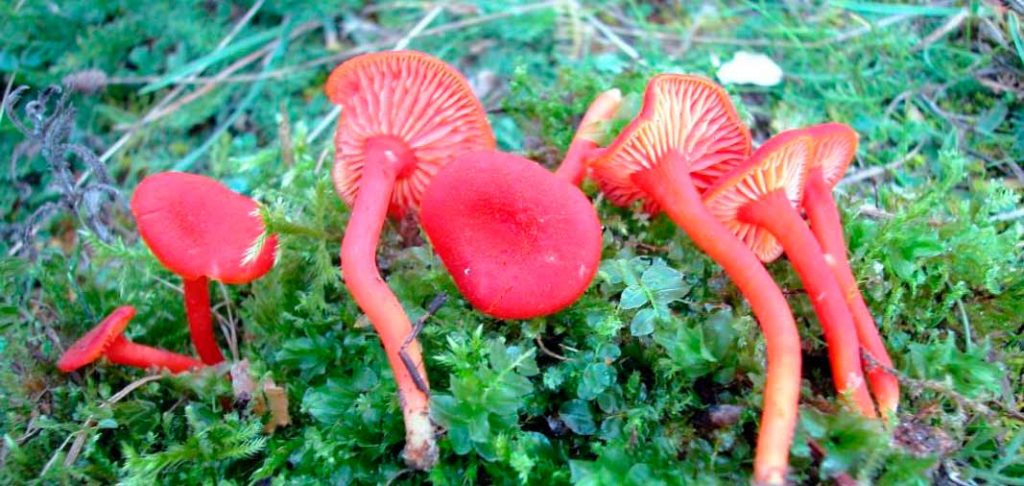
The best pantry in Tarazona area is based on the long list of ingredients produced in the Moncayo. A commitmment to local community. Mushrooms, meats, legumes and vegetables are the central axis of your kitchen.
To the landscape and the ecological and natural richness of of the Dehesa del Moncayo Natural Park, we must add the important source of supply of the most diverse foodstuffs used into a popular cuisine very respectful with their own nature.
Firstly, the mycological universe of the mountain makes mushrooms/edible fungi grow under the best weather conditions: autumnal heavy rains or springtime. Mushroom foraging, also called mushrooming, is an act of adventure consisting on choosing any of such fungi that are edible shortly.
The rivers and streams that divide this region, with its adjoining orchards, allow the growth of some vegetable; chard and borage, commonly associated to the local cuisine. Besides, both asparaguses, not only white but also classic ones, are also used into vegetables stews and grilled vegetables.
Legumes are a good base of stews and traditional recipes, in which the beans of Tarazona, are almost always included. Those that are cooked in the sanctuary of Moncayo, which also incorporate giblets of the pork are absolutely delighful. It is also in this place, where the 1st Sunday of July ends the pilgrimage of Quililay. There “Migas a la Pastora” (traditionally made with leftover bread by shepherds) and beans are eaten. Other gastronomy festivals are the “la recogida de Tortas” (literally collecting the cakes) by the streets of Torrellas from mid-September and those of May in Santa Cruz de Moncayo. Needless to say, these lands offer a huge variety of cheeses made from goat and sheep milk.
Olive oil, coming from olive trees scattered throughout much of the region, honey and artisanal jams from the area closest to Vera de Moncayo, are other food products stocked in the pantry of this area.
Regarding wines, the nearby protected designation of Origin Campo de Borja animates the lunchtime meetings, which usually end with a drink of Chordón liquor that is elaborated with the small aromatic fruits from the Moncayo.
A heap of sensations turns over into mouth watering dishes and recipes with the same intensity of past times.
Culinary art:
All food- lovers who enjoy eating get in the Somontano of Moncayo area, great foods to try. And there’s no need to bring sophistication and elitism to a pretty meal. Tarazona and its region serve up a Taste of region simplicity based on the nature and versatility of its products. One of the important elements of this food, both old and new, is fidelity towards the products and classic recipes.
Generally, this cuisine always seems to have a strong focus on local products and spawn sucesfully beautiful, delicate vegetable-focused food.
Designation of Origin Campo de Borja Wine:
The nearby designation of origin keeps surprising true wine lovers. Native varieties of grapes such as Macabeo, Grenache or Tempranillo, and more international ones, the case of Chardonnay or Cabernet Sauvignon, result in a huge range of options. The Cava also has a presence within the offer of this area with sparkling and cheerful references. Visiting the wineries themselves and buying some bottles as souvenirs, is by itself an epicurean and gourmet delight.
The Grenache Wine Route
The Association for the Tourist Promotion of the Garnacha Route was established in the year 2009, whose headquarters are in the town of Borja. It was founded by Campo de Borja Region and C.R.D.O Campo de Borja, reinforced later with the adhesion of other associations In addition to these local entities, The Grenache wine Route involves wineries, restaurants, wine bars, rural tourism houses, hotels, museums, gourmet shops etc
Wilderness adventures
With an extension around 9,848 hectares, the Moncayo Natural Park is a place of wonder, that every nature- lover should visit. From the rugged natural beauty after climbing to summit all 2,315 meters, to the sweeping outdoor activities in entire nature such as: climbing, mountain biking or zip lines, here are great wilderness adventures.
Foothpaths
The main route that crosses the natural park is the G.R. (long distance) 90 path that runs from Fuente de los Frailes to the summit takes about 5 hours. Somewhat easier is the P.R. (small distance). Moncayo Natural´s Park is distinctive for an endless number of tracks and trails. The one that goes from Malón to the Queiles dam (40 minutes) is highly recommended.
Family Holidays
Spend a family day in the Somontano del Moncayo area, a mixed bag of beautiful and positive emotions lived in the heart of the province of Zaragoza. Both children and adults can enjoy this stunning scenary from the back of a horse.
The descent to the caves of Añón de Moncayo (time estimated: 10 minutes), visiting the Monastery of Veruela or walking from Malón to the Queiles dam (time estimated: 40 minutes), are some other activities to be carried out in groups. If you ever want to encounter the facinating legends and conjure witches and spells, then be sure to visit any of the castles of this area.
Tarazonica Greenpath
It is the old abandoned railway line, that linked Tarazona with Tudela, reopened and allowed for those on foot, horseback or bike. The trail makes its way along Tarazona, Vierlas, Malón and Novallas and shows great uniquely tranquil and picturesque enviroment of the Moncayo and the fertile plain of the Queiles river. Highly recommended to enjoy your day.
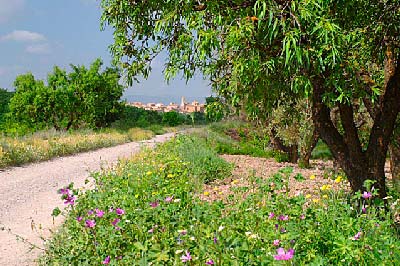
Plans for a Weekend
To schedule a weekend getaway to the Somontano del Moncayo, it is recommended to contact directly the Tourist Information Centre (Plaza San Francisco, 1. Tarazona Tel: 976 64 00 74). There, the friendly staff can offer helpful advice on where to stay and traveller information to help you make the most of your trip to this area. They can also book your stay in advance, depending on this day´s occupancy.
A two-day trip wouldn’t be complete without seeing the top atttactions in the old Turia, as well as the natural park of Moncayo, a must-see on any trip to here. Make sure to tick these top things on your list. The monastery of Veruela (ticket cost €1.80 per person) or the innumerable castles. Even better, you could also soak up some culture at museum Paco Martínez Soria or discover the exhibition of witchcraft of Trasmoz. There are plenty of places to stay in Tarazona on a budget, including charming and friendly rural tourism houses and hotels spread throughout the region. You can find further information about accomodation at the Tarazona tourism office.
